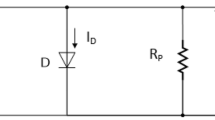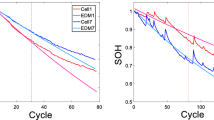Abstract
In order to avoid the overcharge and overdischarge damages, and to improve the lifetime of the lithium-ion batteries, it is essential to keep the cell voltages in a battery pack at the same level, i.e., battery equalization. Based on the bi-directional modified Ćuk converter, variable universe fuzzy controllers are proposed to adaptively maintain equalizing currents between cells of a serially connected battery pack in varying conditions. The inputs to the fuzzy controller are the voltage differences and the average voltages of adjacent cell pairs. A large voltage difference requires large equalizing current while adjacent cells both with low/high voltages can only stand small discharge/charge currents. Compared with the conventional fuzzy control method, the proposed method differs in that the universe can shrink or expand as the effects of the input changes. This is important as the input may change in a small range. Simulation results demonstrate that the proposed variable universe fuzzy control method has fast equalization speed and good adaptiveness for varying conditions.
Similar content being viewed by others
References
Linden D and Reddy T B, Handbook of Batteries, 3rd Edition, McGraw-Hill, New York, 2002.
Raines and Gerald B, Electric Vehicles: Technology, Research and Development, Nova Science, New York, 2009.
Sciarretta A, Serrao L, Dewangan P C, et al., A control benchmark on the energy management of a plug-in hybrid electric vehicle, Control Engineering Practice, 2014, 29: 287–298.
Vetter J, Novak P, and Wagner R, Ageing mechanisms in Lithium-Ion batteries, Journal of Power Sources, 2005, 147: 269–281.
Dubarry M and Liaw B Y, Development of a universal modeling tool for rechargeable lithium batteries, Journal of Power Sources, 2007, 174: 856–860.
Daowd M, Omar N, Bossche P V D, et al., Passive and active battery balancing comparison based on Matlab simulation, Proceedings of the 7th IEEE Conference on Vehicle Power and Propulsion, Chicago, USA, 2011, 1–7.
Gallardo-Lozano J, Romero-Cadaval E, Milanes-Montero M I, et al., Battery equalization active methods, Journal of Power Sources, 2014, 246: 934–942.
Qi J and Lu D D, Review of battery cell balancing techniques, in Proceedings of the 15th Australasian Universities Power Engineering Conference, Perth, Australia, 2014, 1–6.
Nguyen N, Oruganti S K, Na K, et al., An adaptive backward control battery equalization system for serially connected lithium-ion battery packs, IEEE Transactions on Vehicular Technology, 2014, 63: 3651–3660.
Gallardo-Lozano J, Romero-Cadaval E, Milanes-Montero M I, et al., Battery equalization control based on the shunt transistor method, Electrical, Control and Communication Engineering, 2014, 7: 20–27.
Lim C, Lee K, Ku N, et al., A modularized equalization method based on magnetizing energy for a series-connected lithium-ion battery string, IEEE Transactions on Power Electronics, 2014, 29: 1791–1799.
Wang Y, Zhang C, Chen Z, et al., A novel active equalization method for lithium-ion batteries in electric vehicles, Applied Energy, 2015, 145: 36–42.
Dong B, Li Y, and Han Y, Parallel architecture for battery charge equalization, IEEE Transactions on Power Electronics, 2015, 30: 4906–4913.
Lee Y S, Cheng M W, Yang S C, et al., Individual cell equalization for series connected lithium-ion batteries, IEICE Transactions on Communications, 2006, 89(9): 2596–2607.
Ouyang Q, Chen J, Zheng J, et al., Optimal cell-to-cell balancing topology design for serially connected Lithium-Ion battery packs, IEEE Transactions on Sustainable Energy, 2018, 9(1): 350–360.
Lee Y S and Chen M W, Intelligent control battery equalization for series connected Lithium-Ion battery strings, IEEE Transactions on Industrial Electronics, 2005, 52: 1297–1307.
Ouyang Q, Chen J, Zheng J, et al., SOC estimation-based quasi-sliding mode control for cell balancing in Lithium-Ion battery packs, IEEE Transactions on Industrical Electronics, 2018, 65(4): 3427–3436.
Lee Y S and Duh J Y, Fuzzy-controlled individual-cell equaliser using discontinuous inductor current-mode Cûk convertor for Lithium-Ion chemistries, IEEE Proceedings Electric Power Applications, 2005, 152: 1271–1282.
Lee Y S, Cheng D K W, and Wong S C, A new approach to the modeling of converters for spice simulation, IEEE Transactions on Power Electronics, 1992, 7: 741–753.
Lee Y S and Cheng M W, Intelligent control battery equalization for series connected lithium-ion battery strings, IEEE Transactions on Industrial Electronics, 2005, 52(5): 1297–1307.
Yan J, Cheng Z, and Xu G, Fuzzy control for battery equalization based on state of charge, Proceedings of IEEE 72nd Vehicle Technology Conference, Ottawa, Canada, 2010, 1–7.
Li H, Interpolation mechanism of fuzzy control, Science in China Series E: Technological Sciences, 1998, 41(3): 312–320.
Li H, Miao Z, and Lee E, Variable universe stable adaptive fuzzy control of a nonlinear system, Computers & Mathematics with Applications, 2002, 44(5): 799–815.
Chen M and Rincon-Mora G A, Accurate electrical battery model capable of predicting runtime and I-V performance, IEEE Transactions on Energy Conversion, 2006, 21(2): 504–511.
Zhang Z and Cuk S, A high efficiency 1.8 kW battery equalizer, Proceedings the 8th Annual Applied Power Electronics Conference and Exposition, 1993, 221–227.
Maksimovic D and Cuk S, A unified analysis of PWM converters in discontinuous modes, IEEE Transactions on Power Electronics, 1991, 6: 476–490.
Passino K and Yurkovich S, Fuzzy Control, Citeseer, California, 1998.
Author information
Authors and Affiliations
Corresponding author
Additional information
This research was supported by the National Natural Science Foundation of China under Grant Nos. 61433013 and 61621002.
This paper was recommended for publication by Guest Editor XIN Bin.
Rights and permissions
About this article
Cite this article
Zheng, J., Chen, J. & Ouyang, Q. Variable Universe Fuzzy Control for Battery Equalization. J Syst Sci Complex 31, 325–342 (2018). https://doi.org/10.1007/s11424-018-7366-7
Received:
Revised:
Published:
Issue Date:
DOI: https://doi.org/10.1007/s11424-018-7366-7




